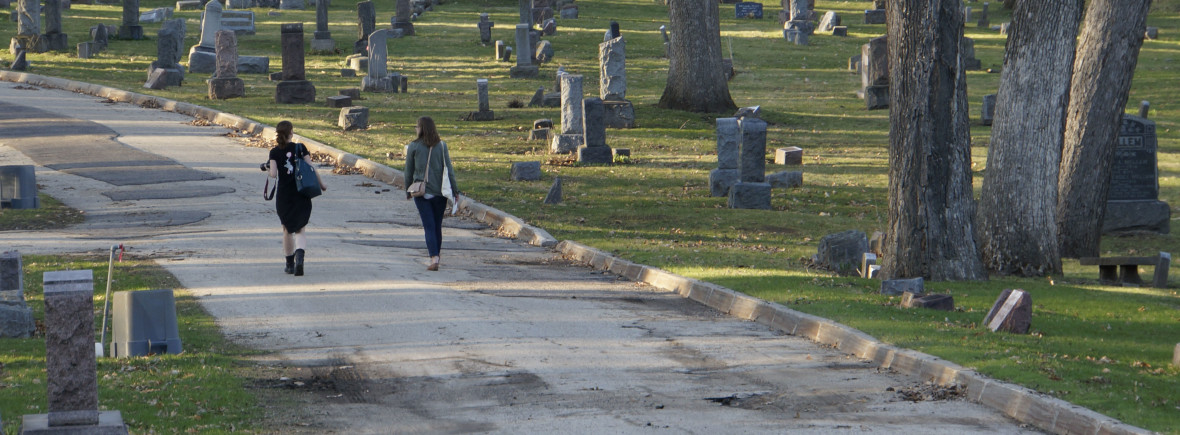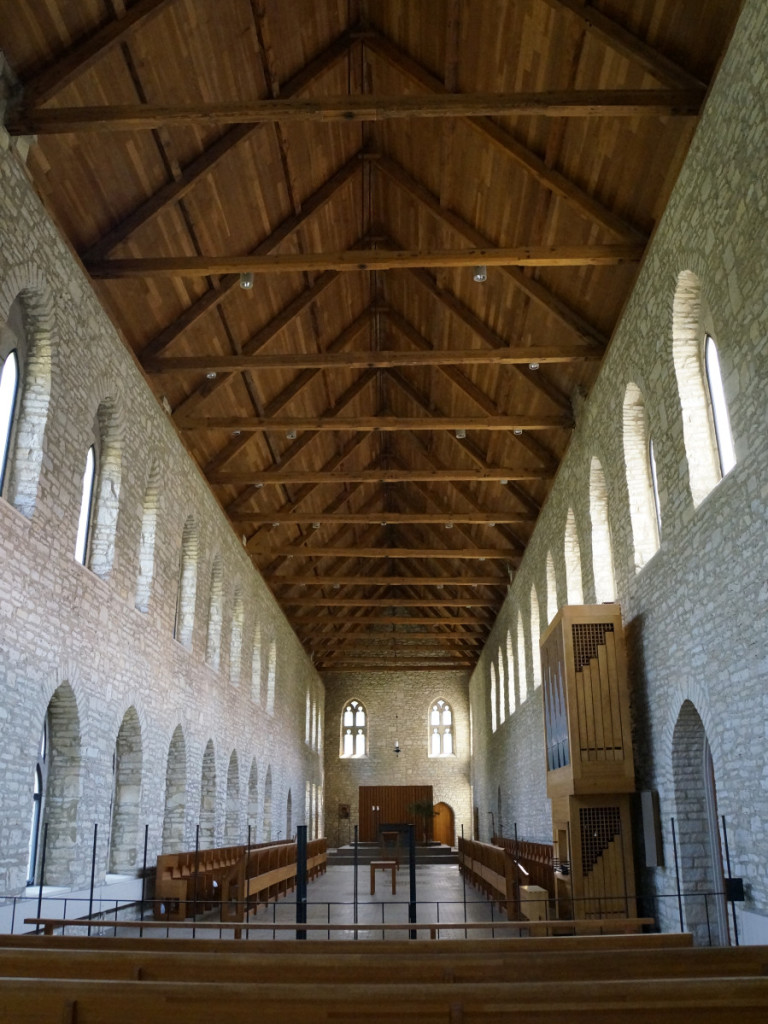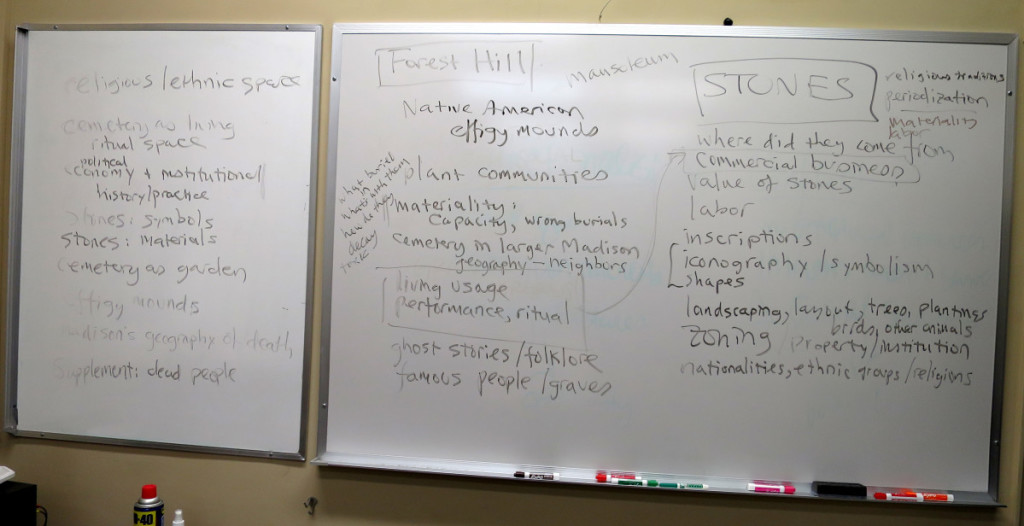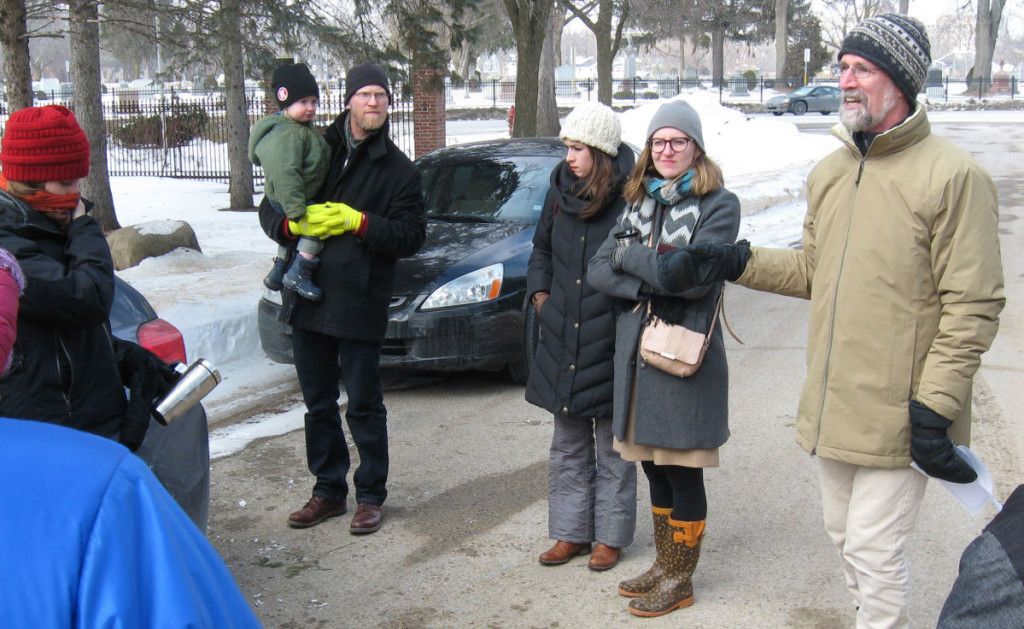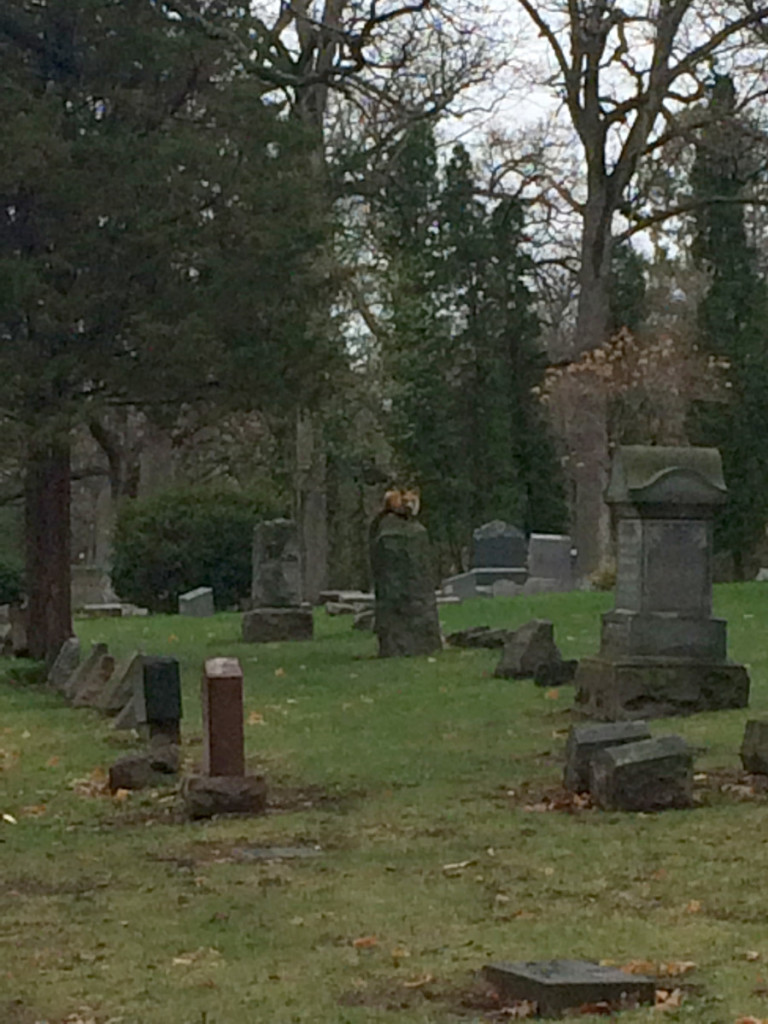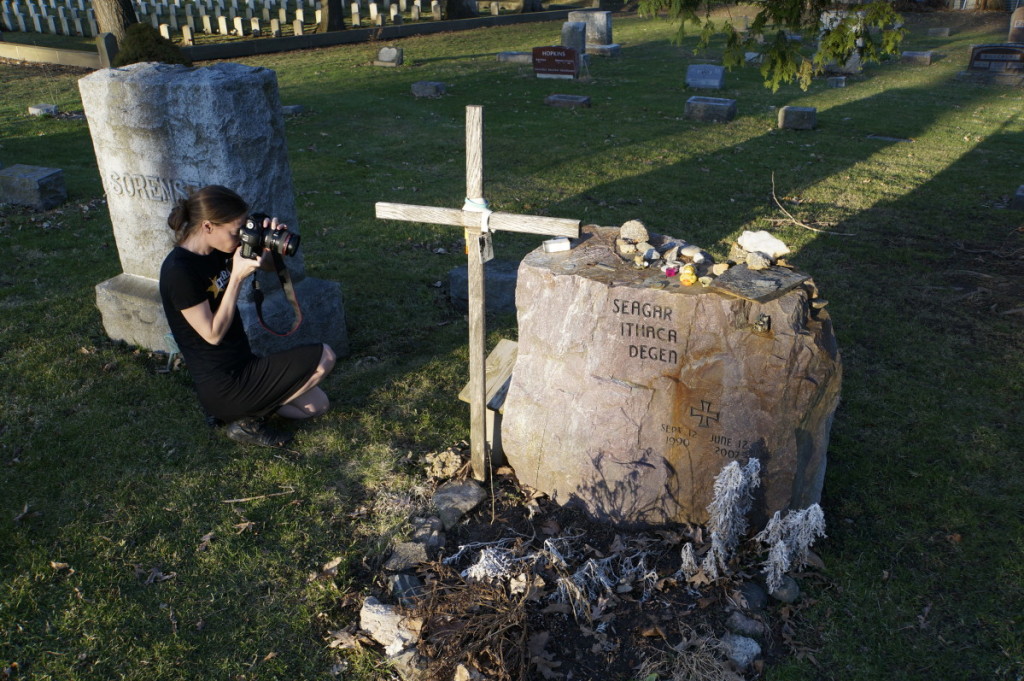The Team
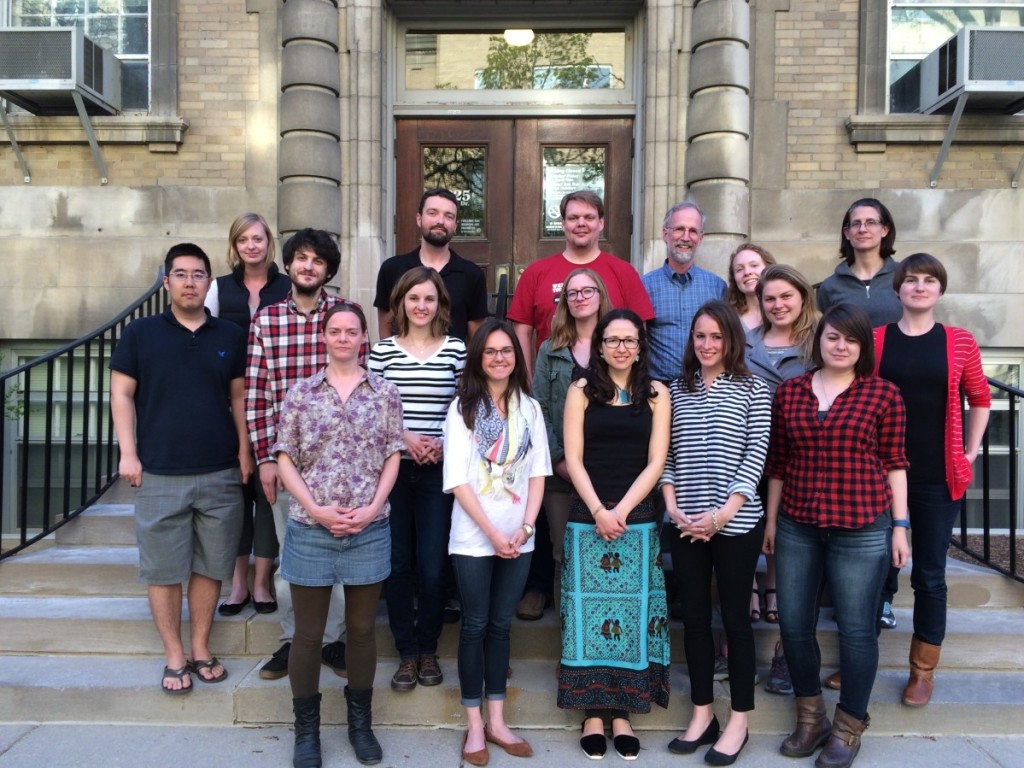
Members of Forest Hill Website Team (left to right): Back: Caitlin Williamson, Charlie Carlin, Kevin Walters, Bill Cronon, Angela Hronek, Christine Scott Thomson; Middle: Michael Hayata, Alex Kris, Nicolle Etchart, Joanna Wilson, Claire Shaller Bjork, Adrienne Hagen; Front: Helen J. Bullard, Lauren Suerth, Gioconda Coello, Marisa Gomez, Bailey Albrecht. Photo by Tony Pietsch.
Authors of Individual Pages:
History: Angela Hronek (Art History)
Landscaping: Claire Shaller Bjork (Environment & Resources), Adrienne Hagen (Classics)
Stones: Marisa Gomez (Architectural History), Christine Thomson (Environment & Resources)
Symbols: Helen J. Bullard (Interdisciplinary Arts), Joanna Wilson (Art History)
Traditions: Gioconda Coello (Southeast Asian Studies), Alexander Kris (English)
Rituals: Michael Hayata (History), Lauren Suerth (Urban & Regional Planning)
Effigy Mounds: Bailey Albrecht (History), Caitlin Williamson (Environmental Conservation)
The Geography of Death: Charles Carlin (Geography), Nicolle Etchart (Geography), Lauren Suerth (Urban & Regional Planning), Kevin Walters (History)
A Body’s Journey: Charles Carlin (Geography), Nicolle Etchart (Geography), Kevin Walters (History)
About This Site: Bill Cronon
Maps and Web Design: Andy Davey (Geography)
WordPress Consulting: Adam Mandelman (Geography)
WHY We Chose Forest Hill
This website was created in the spring semester of 2015 by students in the CHE Methods Seminar, Environmental Studies 922, an interdisciplinary methods course offered each spring by the Center for Culture, History, and Environnent (CHE) of the University of Wisconsin-Madison’s Nelson Institute for Environmental Studies. Numerous CHE faculty members join the seminar each spring to talk about their different disciplines and how they approach the study of environmental change relative to human history and culture. Three CHE professors (Bill Cronon, Lynn Keller, and Gregg Mitman) take turns from year to year organizing the seminar. This year, it was led by Bill Cronon.
While the seminar intentionally remains a work-in-progress each time it is taught, it has several core goals:
- It introduces graduate students from a wide array of departments and programs to different disciplinary and interdisciplinary methods for studying past environmental change and the human cultural contexts within which such change occurs.
- It explores the disparate forms of evidence that can be used to reconstruct past environmental changes and their human meanings.
- It strives to build a strong sense of community among graduate students and faculty members at UW-Madison who share an interest in past environmental change by creating a context within which students from different departments and programs can work together while also getting to know faculty members associated with CHE.
Among the most interesting (and challenging!) features of the seminar is that it is thematically linked each year to a week-long Place-Based Workshop that CHE offers every May. Each year, an ad hoc planning group identifies an environmental theme of interest to members of the CHE community, and then organizes a bus tour visiting landscapes and sites relevant to that theme. To enrich the experience of the Place-Based Workshop, students in the CHE Methods Seminar brainstorm projects that address the workshop theme for that year, ultimately sharing their projects with workshop participants.
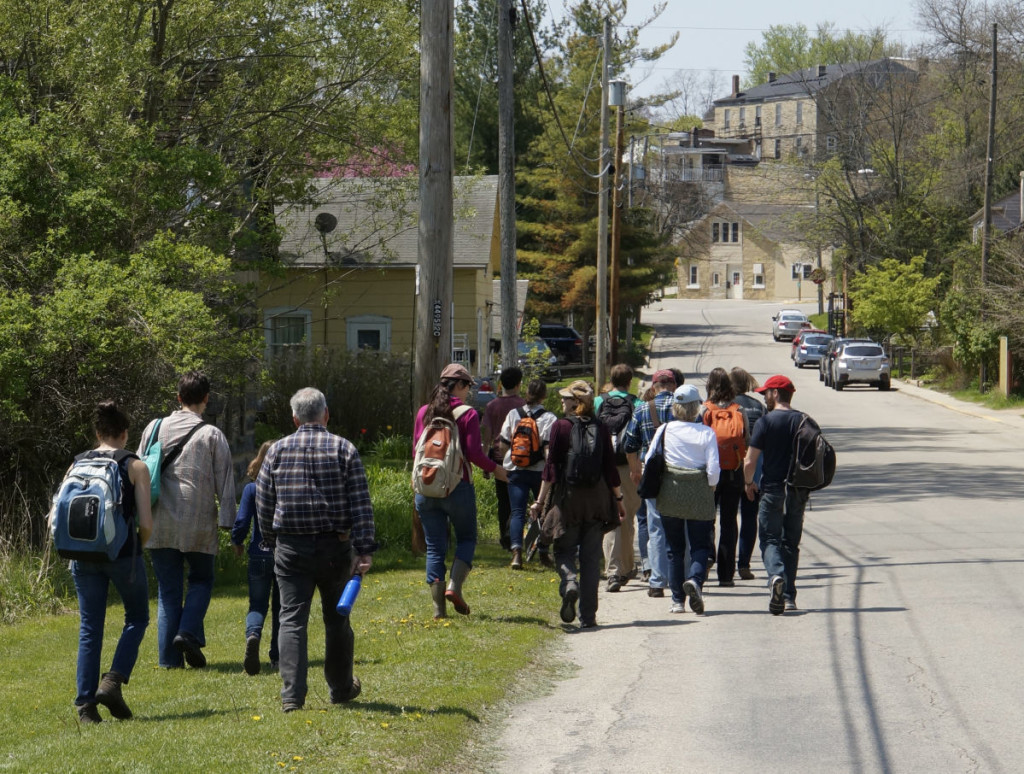
CHE Place-Based Workshop on Extractive Landscapes Visits Mineral Point, Wisconsin, May 2014. Photo by William Cronon.
For May 2015, the theme of the CHE Place-Based Workshop was “Sacred Space, Place, Time,” exploring a wide variety of landscapes and sites that in different ways have been associated with different notions of the sacred. On the itinerary were places ranging from two churches in Madison; the New Melleray Trappist Monastery in Dubuque, Iowa; the Islamic Mother Mosque of America in Cedar Rapids, Iowa; Effigy Mounds National Monument in northeastern Iowa; Durward’s Glen in Wisconsin’s Baraboo Hills; the Wisconsin Dells; and Aldo Leopold’s Shack. Each of these has been a place of worship or pilgrimage or other experiences that Leopold (following Rudolf Otto) sometimes called numinous. Because such sites have been so central to human conceptions of nature and the environment, they seemed well suited to the Place-Based Workshop format.
The challenge for students in the Methods Seminar was to decide what they might do together—especially given the very different disciplinary backgrounds students always bring to this seminar—that would contribute to such a broad and (for CHE) relatively unusual theme. We spent two or three weeks brainstorming possible projects, and for a while imagined that teams of students might do a pair of projects interpreting the interior and exterior geographies of different worship spaces, comparing (for instance) the layouts and symbolic meanings one might typically find in a Catholic cathedral, a Lutheran church, a Jewish synagogue, a Buddhist temple, and so on. Those ideas gradually fell by the wayside, however, as we focused on a site that we knew the Place-Based Workshop would visit for several hours on the very first morning of the field trip: Forest Hill Cemetery, the oldest and largest cemetery in Madison, conveniently located just a mile and a half from where our seminar met.
There’s no need to repeat on this page the many aspects of Forest Hill that makes it such a fascinating place; you can get a quick introduction to the place on our home page and on the History page. For the purposes of our big seminar project, the cemetery had many advantages. It is a rich, complex landscape steeped in history, encompassing many different religious and ethnic traditions, many of them expressing deeply held beliefs about nature and the sacred in the ways the people buried there (and the people burying them) memorialized those lives. Although many people don’t appreciate just how fascinating cemeteries can be if only one pays sufficiently close attention to them, that very fact led us to believe that an eclectically quirky but well organized website might be a way of sharing CHE’s interdisciplinary approaches to culture, history, and environment not just with participants in the Place-Based Workshop, but with members of the public interested in this important Madison cemetery that too few of the city’s residents know.
Our Process
Because one of the chief goals of the CHE Methods Seminar is not just to talk about interdisciplinary research but to give students an experience of actually doing it, it was important that we not have a preconceived notion of how to approach creating a website about a cemetery. Although Bill Cronon has constructed websites with his classes in the past, he had no more idea of how to construct a website about Forest Hill Cemetery than the students did. We were aided from the outset by visits from CHE faculty members who shared disciplinary approaches especially relevant to sacred space, place, and time, and we typically asked them about how they themselves would approach the interpretation of a cemetery as part of our conversation with them.
We were fortunate that one of our earliest visitors was CHE Faculty Associate Anna Andrzejewski, an art historian specializing in the study of vernacular landscapes who helped us think about how to interpret places like Forest Hill. No less important, Anna brought along one of her graduate students, Angela Hronek, who through pure serendipity turned out to be completing a master’s thesis on Forest Hill Cemetery. Angela’s presentation was invaluable in giving us a basic orientation to the place, helping students identify readings, people, and archival sources for their research. She ultimately agreed to contribute an introductory essay about the cemetery’s History that for many visitors will be the best place to start exploring this site. Her contributions were so significant that we eventually came to regard her as a full member of our website team even though she was not enrolled in the class, and you will find her picture in the photograph at the top of this page as a result. We are very grateful for the generosity with which she shared her knowledge.
Having spent a session or two talking generally about what our website might offer to interested visitors, we began to brainstorm themes we might wish to explore in detail. We did so seeking to identify essential topics that anyone wishing to learn about cemeteries would want to know, while also considering the disciplinary backgrounds and interests of the students who would produce web pages addressing these themes.
The crucial brainstorming session took place during just the third session of the class, on February 3, when we spent an hour filling our whiteboard with the thematic categories that would eventually provide the architecture of this website. A week later, we identified the teams that would take responsibility for the different web pages addressing themes, and from that point on we were off and running. Students began doing background reading, visiting archives, interviewing faculty members and community members with knowledge of the topic about which particular teams would be writing, and generally gaining the knowledge that they would ultimately translate into the pages of this website.
Most of us involved in the project would probably agree that an especially important benchmark came on February 21, when we gathered on a Saturday afternoon to spend a couple of hours touring the cemetery. One disadvantage of doing a project like this during the spring semester in Wisconsin is that it’s still deep winter in January and February: conditions are pretty cold for spending extended periods outdoors, and many graves are in fact covered with snow. We were fortunate that although Madison had a pretty cold February and conditions the week before had been unusually blustery, it was relatively calm and warm (by Wisconsin standards!) on the day of our tour. Most of the students had not yet been to the cemetery before that day. Talking about it together and seeing it through the lenses of their different thematic web pages made it come much more vividly alive.
From that point on, and especially once the snow had begun to melt in March, team members began to wander around the cemetery whenever time and circumstances permitted. Websites work best when they’re well illustrated, and one of the big advantages of a cemetery is that there are so many things to photograph there. One class member, Adrienne Hagen in Classics, had one of the most unusual experiences of any of us during a late afternoon visit when she happened upon a red fox perched atop a grave stone. Although lighting conditions weren’t great, she had the presence of mind to snap a photograph to record the moment…a reminder that cemeteries are far from just being places of death. Romantic rural cemeteries like Forest Hill were actually constructed to mimic very particular kinds of wooded pastoral habitat that many animals find hospitable. Indeed, if you’re ever able to visit Forest Hill right around dusk in mid-to-late June, you’ll be treated to one of the most spectacular firefly displays anywhere in the Midwest. Don’t miss it!
The Website Itself
In the past, the websites Bill Cronon has built with his students have typically been programmed from scratch, generating an enormous amount of work both for him and for students possessing the coding skills to help with the underlying site architectures. Indeed, so formidable can be the labor involved that on a couple of occasions the sites students constructed never actually went live because the final cleanup and programming work was never completed (for which Bill continues to feel guilty on behalf of those students, given the spectacular work they did on those websites).
So for this site, we tried a different approach, based in large part on the positive experience that a group of CHE graduate students have had starting in 2014 publishing a biweekly blog called Edge Effects in a WordPress environment.
WordPress has many advantages for a shared classroom project like this one. Because it offers an open-source platform for blogging and web design, the number of pre-written themes and plug-ins available for modifying a site’s functionality is truly enormous. This spares students and teachers alike from the programming labor that a built-from-scratch website requires. Furthermore, WordPress has been pre-programmed for the responsive design features that are now essential given the many different platforms—desktops, laptops, tablets, and smartphones—that visitors now expect to use for consulting websites. By choosing WordPress, we guaranteed that this site about a cemetery could be consulted and read in the comfort of people’s homes, but would work just as well if people wanted to review its contents on their phones while visiting the cemetery. Best of all, WordPress has been designed from the beginning to make it easy for people with very little programming experience to build quite sophisticated blogging platforms and websites. That was ideal for a seminar like this one, which was never intended as a computer programming class but as an introduction to interdisciplinary methods. WordPress makes it easy for large groups of people to collaborate in creating, reviewing, editing, and revising web content, and that too could not have been better suited to the needs of this class.
Having decided to commit to WordPress, Bill asked one of his CHE graduate students, Andy Davey, a geographer, to assist in selecting a theme; laying out the basic architecture of the site; and creating some sample pages for students to use as models. Because we intended this to become a static website, not a regularly updated blog, we chose for our platform a WordPress theme called Sela, by Automattic, in part because it provided some of the functions we needed for handling the large number of photographs we expected would be displayed on the site. We also added the FooBox plug-in to increase our options for displaying photographs. In modifying Sela and WordPress to serve the needs of this site, Andy Davey did heroic labor on our behalf, aided as needed by the wise counsel of Adam Mandelman, another CHE graduate associate in Geography, who gained intimate knowledge of WordPress while leading the team that created the Edge Effects blog. Adam and Andy together led a two-hour workshop for students in the seminar to introduce them to working in a WordPress environment, and from then on the software was user-friendly enough that students were able to develop web content without too much assistance. We are hugely grateful to both Adam and Andy for the labor they contributed to make this site possible.
For others considering doing course projects like this one, our experience leads us to recommend WordPress as nearly ideal for most purposes—and, in fact, far superior to the kinds of hard-coded websites that Bill has developed in the past. There is one major caveat, though, which anyone contemplating a project like this one would do well to keep in mind. Because students were taking their own photographs and loading them into the Media Library where WordPress stores images, we were not sufficiently careful about the sizes of files being added to the WordPress database. Bill had instructed students to resize their images so that they would be no more than 1200 pixels on their long dimensions, but he forgot to caution them to save these reduced files at low-resolution JPG settings. As a result, a great many files got loaded onto the site that ranged upwards from 1 to more than 10 megabytes…huge by the standards of the Web, so much so that this website eventually became several gigabytes in size before Bill realized what was happening.
WordPress does not make it easy to identify and modify large files like these once they have been added to its Media Library—an aspect of the software that has rightly drawn many complaints over the years—so it took many anxious hours before the problem was finally resolved. (Here too Adam Mandelman was especially helpful in resolving some particularly knotty JPG processing challenges, including at odd hours of the day when he had better things to be doing with his time.) The technical advice Bill would offer is that a group project like this one should be rigorous in insisting on very strict rules about the sizes and resolutions of JPG files added to the WordPress Media Library. The best current plug-in for automating such restrictions—with the ability to shrink and resample JPG files on the fly while they are being loaded—appears to be Imsanity, which Bill would recommend should be installed right from the start, with settings carefully calibrated to shrink any large image files to the (small!) maximum size actually needed by the site. Bill wishes he had known enough to do this from the very beginning.
This technical problem aside, we are very pleased with what the WordPress environment has enabled us to accomplish in the brief three months that we’ve been working together to produce this website. We very much hope you enjoy and learn from the materials we’ve assembled here, and that the site will inspire visitors to contemplate doing similar projects on places and topics they care about.
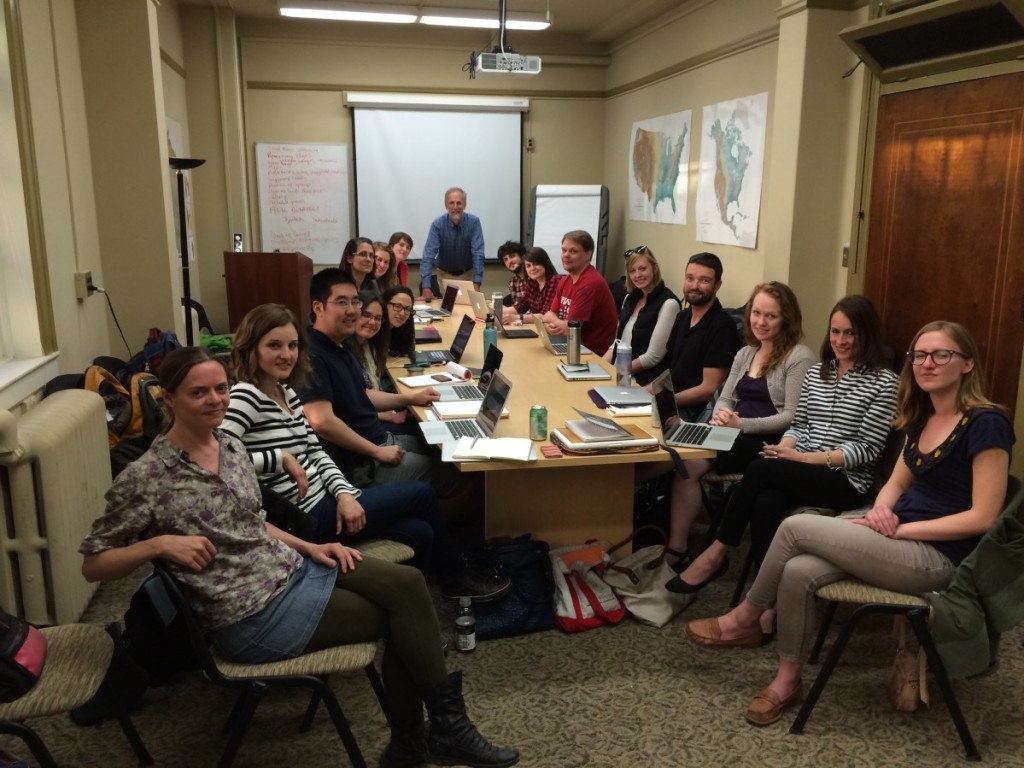
CHE Methods Seminar Class Members (left to right): Helen J. Bullard, Nicolle Etchart, Michael Hayata, Lauren Suerth, Gioconda Coello, Christine Scott Thomson, Claire Shaller Bjork, Adrienne Hagen, Bill Cronon, Alexander Kris, Bailey Albrecht, Kevin Walters, Caitlin Williamson, Charlie Carlin, Angela Hronek, Marisa Gomez, Joanna Wilson. Photo by Tony Pietsch.
Special Thanks to:
Anna Andrzejewski, CHE Faculty Associate, Art History, University of Wisconsin-Madison
Joanne Austin, City of Madison Parks Administration
Brad Baranowski, History, University of Wisconsin-Madison
Laura Bauer, Parks Supervisor at Forest Hill
William Clark, Cress Funeral Home
Charles Cohen, History UW Madison
Mark Cupp, Executive Director of the Lower Wisconsin State Riverway Board and Board President of Cultural Landscape Legacies
Michael Edmonds, Wisconsin Historical Society
Anna Gade, CHE Faculty Associate, Religious Studies, University of Wisconsin-Madison
Mark Gajewski, Historic Madison, Inc.
Sara Hotchkiss, CHE Faculty Associate, Botany, University of Wisconsin-Madison
Angela Hronek, Art History, University of Wisconsin-Madison
Barry Irmen, Chief of Operations at Dane County’s Medical Examiner’s Office
Lynn Keller, CHE Faculty Associate, English, University of Wisconsin-Madison
Choua Lee, Southeast Asian Studies UW Madison
Adam Mandelman, CHE Graduate Associate, Geography, University of Wisconsin-Madison
Cathy Middlecamp, CHE Faculty Associate, Nelson Institute for Environmental Studies, University of Wisconsin-Madison
Father Mark Miller, St. Paul Church
Garrett Nelson, CHE Graduate Associate, Geography, University of Wisconsin-Madison
Larry Nesper, CHE Faculty Associate, Anthropology, University of Wisconsin-Madison
Gary Pechmann, Pechmann Memorials
Reverend Brad Pohlman, Lutheran Memorial Church
Jonathan Pollack, Center for Jewish Studies, University of Wisconsin-Madison
Ulrich Rosenhagen, Religious Studies UW Madison
Sarah Thal, CHE Faculty Associate, History, University of Wisconsin-Madison
Karen Thompson, Program Assistant at Forest Hill
Matt Turner, CHE Faculty Associate, Geography, University of Wisconsin-Madison
The Wisconsin Historical Society for permission to reproduce archival photographs
Seethong Yang, Southeast Asian Studies UW Madison
